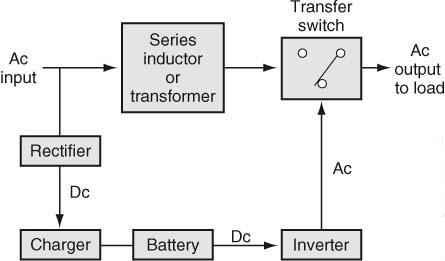A UPS system consists of a rechargeable battery, a rectifier and battery charger, a static inverter, and a power transfer switch. Two types of UPS systems exist: double- and single-conversion UPS systems.
Although primary protectors, regulators, and backup power often serve to protect most systems from momentary or even prolonged outages, more sensitive systems, such as computer or telecommunications equipment, need to have a more stable level of protection. Computer networking systems, in particular, can sustain permanent damage from a single power surge or lightning strike. The surge can travel instantly from an outside transformer through connecting wires, data, and phone lines and into computer devices and peripherals such as modems, routers, switches, and network hubs. One direct hit can permanently damage motherboards, memory chips, and network interface cards (NICs). As a result, thousands of dollars of equipment could be lost in an instant.
To help prevent such an occurrence, computer and telecommunications systems need a more robust system of protection. Static uninterruptible power supplies (UPSs) can provide such protection.
A UPS is an electronically controlled power system that provides ac regulation and filtering to loads requiring consistent, uninterrupted, steady-state power during a partial or even total failure of the main supply input.
A variety of UPS systems are available that offer a wide range of configuration options, often based on the design and size of the system. Additional options often include power line conditioning, lightning protection, EMI protection, and redundancy. The size and capacity of a UPS can range from less than 100 W to as high as several megawatts. Single- or three-phase outputs also are available, with typical frequencies of 50, 60, or 400 Hz. The output waveform also can vary from that of a near-perfect sine wave to a square wave, depending on the design of the system.
A UPS system consists of a rechargeable battery, a rectifier and battery charger, a static inverter, and a power transfer switch. Two types of UPS systems exist: double- and single-conversion UPS systems.
Double-Conversion Uninterruptible Power Supply (UPS)
Figure 1 provides a block diagram of the double-conversion UPS system. The system first converts the original ac into dc. As a result, all harmonic distortions, noise, power surges, and power lulls are removed from the source. The dc then drives the input of a static inverter. The inverter reconverts the rectified dc back into a pure, filtered, ac source for use by the connecting load. The battery provides a means of secondary power to the inverter during the momentary or long-term loss of primary ac at the input. In most cases, a zero time transfer between the rectifier and battery can be obtained because they are connected in parallel at the inverter. The inverter continues to function, uninterrupted, for a predetermined amount of time-based on the capacity of the battery and power requirements of the connecting load.

Figure 1 Double-conversion uninterruptible power supply (UPS) block diagram
The double-conversion UPS system is the electrical equivalent of a motor-driven generator. The advantages of using a double-conversion UPS system include excellent frequency stability, a high degree of isolation from the primary ac line, and quiet, low-decibel operation because there are no moving parts.
Low-power, double-conversion UPS systems providing less than 20 kW often can have the following disadvantages compared with higher power systems: They require larger dc supplies (typically 1.5 times larger than the maximum load rating of the UPS); they are lower in efficiency; they provide poor noise isolation between the line and load; and they dissipate more heat, which often can shorten the useful service life of the device.
Single-Conversion Uninterruptible Power Supply
The single-conversion UPS system uses a transfer-switching circuit for switching the output between the ac input and the output of the inverter. Figure 2 provides a block diagram of single-conversion UPS.

Figure 2 Single-conversion uninterruptible power supply (UPS) block diagram
In such a system, the ac power is supplied to the load through a series inductor or an isolating transformer. The series inductor method helps to smooth out any power surges and power lulls on the input. In the single-conversion UPS system, the inverter output is used only as a backup when the main ac input fails. The battery charger maintains a full charge on the battery only while the ac input is present. During a power failure, the inverter is only able to supply a useful output for a predetermined amount of time-based on the capacity of the battery and the power requirements of the connecting load.
